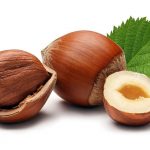 The word hazelnut is a native English word, dating back to at least the eighth century. In the early fifteenth century, however, hazelnuts also came to be known as filberts, a name introduced by the French, who called the nut noix de Philibert because it is usually ready to be harvested on St. Philibert’s day, August 22 (incidentally, in Old German, Philibert’s name means very bright). Ironically, after giving English the word filbert, the French themselves ceased to call the nut Philibert and instead started to refer to it either as noisette (a word derived from noix, the French word for nut) or as aveline (a word derived from Avella, the name of an Italian town famous for its nuts and fruit, and possibly the source of the word apple). Later on, the French also transferred the name noisette to certain cuts of beef or mutton that are small and round like a nut, and are surrounded by a layer of fat resembling a shell. English adopted noisette with this cut-of-meat sense in the late nineteenth century.
The word hazelnut is a native English word, dating back to at least the eighth century. In the early fifteenth century, however, hazelnuts also came to be known as filberts, a name introduced by the French, who called the nut noix de Philibert because it is usually ready to be harvested on St. Philibert’s day, August 22 (incidentally, in Old German, Philibert’s name means very bright). Ironically, after giving English the word filbert, the French themselves ceased to call the nut Philibert and instead started to refer to it either as noisette (a word derived from noix, the French word for nut) or as aveline (a word derived from Avella, the name of an Italian town famous for its nuts and fruit, and possibly the source of the word apple). Later on, the French also transferred the name noisette to certain cuts of beef or mutton that are small and round like a nut, and are surrounded by a layer of fat resembling a shell. English adopted noisette with this cut-of-meat sense in the late nineteenth century.
The European hazelnut, also known as the filbert nut, is a type of nut commonly found in Europe. One of the key distinguishing features of this variety is its fringed husk, which is notably longer than that of the North American hazelnut. This husk is an outer layer that surrounds the nut, and provides both protection and flavor. The European hazelnut has a sweet and nutty flavor, and is a popular ingredient in a variety of desserts, including cakes, chocolates, and pastries. Its unique taste and texture make it a sought-after ingredient for both home cooks and professional bakers.
The hazelnut species you are referring to is called “filberts”. Filberts are grown in several countries including California, England, Turkey, Italy, and Spain. They are characterized by their elongated shape and long, fringed husks. Filberts are a popular type of nut that can be eaten raw or roasted, and are used in a variety of culinary applications such as baking, confectionery, and as a topping for salads and other dishes. They are also a good source of healthy fats, fiber, and vitamins and minerals.
